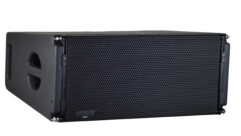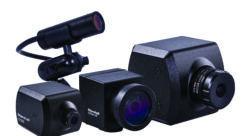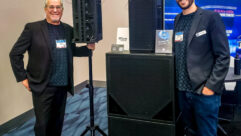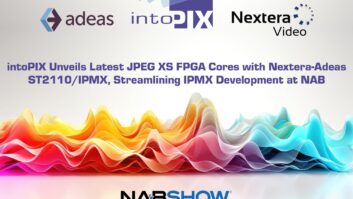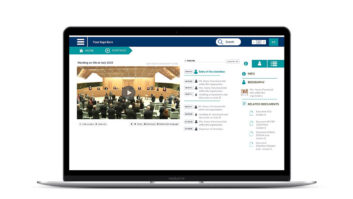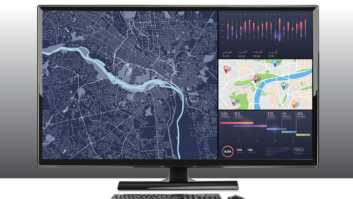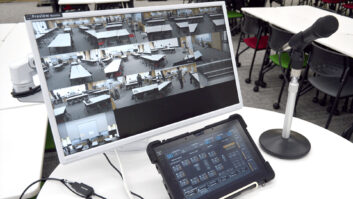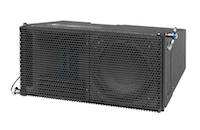

Line Array Technology Showcase
Oct 3, 2011 10:42 AM,
By Mark Johnson
Alcons Audio LR7
The line starts here: While line array theory has been known since the late 1950s, and has been seen in various incarnations in pro audio over time, we can probably credit Dr. Christian Heil of L-Acoustics for bringing the line array back into vogue this time around. And while it’s always been an idea whose time has come, it looks like it’s here to stay. Since the 1990s line arrays have been all the rage (again), but now they are continuing to remain popular and viable tools for sound reinforcement applications. While not necessarily the be-all end-all, given the options available, there is probably some implementation of a line-array system can service a large percent of the applications in the field.
Line arrays come in many flavors from ultra compact to large-scale touring systems; systems intended for installation; to updated versions of the time-proven columns; to even more updated digitally steerable versions. Though the trend seems to be heading to smaller “micro” line arrays and columns. Currently available systems are constructed of any imaginable product, including composite, stainless steel, plastic, and the old standby, wood.
There are undeniably a substantial number of manufacturers who produce some type of line-array system. In the past, to keep things manageable, we’ve limited these to a certain implementation of the technology. However, for this one, we’ll look around the market place and include products from manufacturer lineups that are interesting representations of the technology. Note that many of the manufacturers listed also produce a variety of systems, so be sure to visit the websites listed for additional product information.
Presented in an ultra-compact form factor, Adamson’s Metrix two-way line source comprises an 8.5in. Kevlar neodymium mid-low driver and a 1.4in. high-frequency compression driver mounted to a patented high-frequency wave-shaping chamber. Designed for application in arrays of at least six elements, the coverage pattern is 5 degrees vertical by 120 degrees horizontal. The Metrix-i incorporates Enclosed Installation Rigging (EIR), which provides a cost effective version for installs. The weight for the “i” version is 43.5lbs. and frequency response is 95Hz to 18kHz with a peak SPL of 132.5dB.
The diminutive Alcons Audio LR7 weighs in at a mere 17.6lbs. and features 120-degree horizontal coverage from the RBN401 4in. pro-ribbon high-frequency driver with a “Morpher” lens. The two-way system uses a 6.5in. low-frequency driver, and the overall frequency response is 74Hz to 20,000Hz. In addition a 90-degree horizontal coverage version is available. Vertical coverage for a single element is 15 degrees. The system may be flown or stacked.

Bose Panaray MA12EX
The Panaray MA12EX from Bose is a column design and an update from the MA12. The EX version provides low frequency response down to 75Hz (-3 dB) with an articulated array of 12 2.25in. high-excursion, weather-resistant drivers. High frequency response is 13kHz (-3dB). The 38.8in. tall powder-coated aluminum enclosure is finished in either black or white and is rated for outdoor application. The calculated maximum SPL is 109dB and coverage 160 degrees horizontal by 20 degrees vertical.

Community Professional Entasys
The Community Professional Loudspeakers Entasys column line-array system is a three-way design comprising six neodymium low-frequency drivers, 18 2.35in. mid-frequency drivers, and 42 1in. high-frequency drivers mounted in six 7″x1″ Compact Ribbon Emulator (CRE) high-frequency elements. The coverage is 120 degrees horizontal and user-configurable for a 6- or 12-degree vertical coverage angle. Maximum SPL is 122db (120dB in curved configuration). Frequency response is 200Hz to 20kHz and an optional low-frequency extension column is available.
The Ti10L is the installation version of the T10 loudspeaker from d&b audiotechnik. The hard-foam polyurethane cabinet is loaded with two 6.5in. drivers in a dipolar arrangement and a 1.4in. exit compression high-frequency driver. The HF driver is fitted to a rotatable waveguide. The frequency response is 68Hz to 18kHz with a maximum SPL of 132dB. Horizontal coverage is 105 degrees. The cabinet weight is 24lbs.

dB Technologies DVA T4
The dB Technologies DVA T4 is a three-way self-powered system driven with Class T digital amplifier technology. A switchmode power supply is featured that will accept mains voltages from 90V to 240V. The polypropylene enclosure houses an 8in. low-frequency driver, a 6.5in. horn-loaded mid-frequency driver, and two 1in. compression drivers. System response is 80Hz to 19,000Hz with a maximum SPL of 128dB. Coverage is 100 degrees horizontal by 15 degrees vertical.
Duran Audio offers a choice of the Axys Intellivox range of digitally steerable self-powered column array or the Axys Target range of scaleable line source elements. Both systems feature on board DSP. The Intellivox Ivx-DS808 employs multichannel Class AB amplifiers that power six 6.5in. drivers and two 1in. compression drivers that provide a frequency response of 130Hz to 18kHz. Horizontal coverage is 110 degrees, and the vertical coverage is variable. Maximum peak SPL is 105dB. Column height is 50.31in.

EAW JFL210
EAW manufactures a column loudspeaker as well as the JFL210 compact two-way line-array module (among others). The JFL210 comprises two 10in. cone low-frequency drivers and one 1.4in. exit compression driver. The operating frequency range is 65Hz to 18.8kHz. The system provides two operating modes—either single-amp or biamp, and the peak calculated axial output limit is 130dB. Coverage is 110 degrees horizontal and 15 degrees vertical.

Electro-Voice EVA Series
The Electro-Voice EVA Series consists of four different module configurations that provide two different horizontal coverage angles (90 degrees and 120 degrees) and two different vertical coverage angles (6 degrees and 20 degrees). Each module comprises two two-way elements, with each element made up of an 8in. low-frequency driver and two 1.25in. compression drivers mounted to a hydra/waveguide combination and integral rigging. System frequency response is 60Hz to 19kHz and maximum calculated SPL is 135dB peak.
Line Array Technology Showcase
Oct 3, 2011 10:42 AM,
By Mark Johnson

JBL 70J-1
Another manufacturer providing both column and line source elements is JBL. The CBT series features the 70J-1 model that uses a 70cm “J”-shaped column array with patent-pending Constant Beamwidth technology. The driver complement is 16 1in. tweeters and four 5in. woofers that provide a frequency response of 60Hz to 20kHz. The system provides an asymmetrical vertical coverage pattern that is switchable between 25 degrees or 45 degrees; horizontal coverage is 150 degrees. Maximum SPL is 127dB peak.
One of the more recent players is K-Array. The KK100 features 16 2in. neodymium transducers mounted in a 41.02in. tall stainless steel chassis. The impedance is selectable between 8Ω or 32Ω, and the operating frequency range is 150 Hz to 20 kHz. The coverage is 100 degrees horizontal and 7 degrees vertical with a peak SPL of 125dB. The system weight is 8.38 lbs. Additional products such as the KKS50 or the KL12 sub can be used to extend the operating frequency range.

L-Acoustics KARAi
From L-Acoustics comes the KARAi modular line source element, which is a two-way biamplified system comprised of two 8in. neodymium low-frequency drivers and a 3in. neodymium diaphragm high-frequency driver coupled to a DOSC waveguide. Horizontal coverage is 100 degrees and maximum SPL is 139dB. The frequency response is 55Hz to 20kHz. Addition of the SB18i low-frequency extension lowers the response to 32Hz.

Mackie HDA
New from Mackie is the HDA arrayable powered loudspeaker, which incorporates Class D Fast Recovery amplification with a switch-mode power supply. Amplifier power is 500W RMS for the lows and 100W RMS for the highs. An EAW-designed 12in. low-frequency transducer and two 1.7in. compression drivers provide a frequency response of 57Hz to 20kHz and a maximum calculated peak SPL of 134dB. Horizontal coverage is 110 degrees and the vertical coverage is 20 degrees.

Martin Audio OmniLine
Coming in at just 7.9lbs. for one module, Martin Audio’s OmniLine micro line array is perhaps the smallest of the modular systems. The frequency response of one two-way element is 85Hz to 20kHz from complement of two 3.5in. low-frequency drivers and five 0.55in. soft dome tweeters. Coverage is 100 degrees horizontal and 5 degrees vertical and maximum SPL is 110dB peak from a single element. The system is scalable from four to 32 modules.

Meyer Sound Mina
Meyer Sound’s product line up also includes column array loudspeakers and line array elements. The self-powered Mina compact curvilinear array loudspeaker is the smallest within the Milo family at a little more than 20in. wide with rigging. The frequency response is 66Hz to 18kHz and the maximum peak SPL is 128dB. The system uses two 6.5in. low-frequency transducers, one 3in. diaphragm, and 1.2in. exit compression high-frequency driver, which is coupled to a proprietary Ribbon Emulation Manifold (REM) and a 100-degree horizontal constant directivity horn.

Nexo S805
The Geo line from Nexo includes the S805 array module, which is loaded with an 8in. long-excursion neodymium woofer and one 1in. throat neodymium driver mounted on a Hyperboloid Reflective Wavesource. Coverage in the non-coupling plane is configurable to 120 degrees or 80 degrees. The frequency response is 67Hz to 19kHz. The weight is 28.6lbs. The Geo S805 can be used in arrays in conjunction with the Geo S830 and CD 12 Sub-Bass cabinets.

Outline Mini-COMPASS iMode
Packing a lot of technology in a relatively small package, Outline‘s self-powered Mini-COM.P.A.S.S. iMode boasts onboard DSP and a built-in web server for system control via standard web browser. Also featured is variable asymmetrical horizontal directivity, which allows coverage to be set in steps of 15 degrees from 60 degrees to 150 degrees. Frequency response is 100Hz to 20kHz from a driver complement of four 5in. vented-loaded woofers and two 1.75in. compression drivers. Peak SPL is 131dB.

Peavey SSE LA
Peavey Electronics offers line source modules and a column system through its Architectural and Sanctuary series divisions, respectively. The SSE LA column comprises 16 2in. drivers on a compound-radius curved line array, which provides dual coverage 20 degrees vertical for long throw and 40 degrees vertical for the near field. Horizontal coverage is 130 degrees. Frequency response is 174Hz to 18kHz and maximum SPL 122dB peak.

QSC KLA 12
QSC’s KLA 12 is a self-powered two-way system with a 12in. cone transducer and a 1.75in. compression high-frequency driver mounted in an ABS enclosure. Ar-Q (Arquate Equalization) processing allows for array tuning for the number of cabinets used in the array. Coverage is 90 degrees horizontal by 18 degrees vertical and maximum SPL is 131dB. The amplifier design allows for up to five KLA 12s (or any combination of KLA 12s and its companion subwoofer, KLA 181) to be powered off a 15-amp/120V electrical circuit.

Renkus-Heinz Iconyx IC Live
Another manufacturer with line source elements and column designs is Renkus-Heinz. The Iconyx IC Live digitally steerable line array allows the user to define the opening angles for up to four beams per array module. Eight Class-D amplifier channels with integral DSP drive five 6.5in. low-frequency transducers and three 1in. compression drivers. The frequency range is 80Hz to 20kHz and peak SPL is105dB at 100ft. Horizontal coverage is 150 degrees to 3kHz and 120 degrees above 3kHz. Vertical opening angles for a single module are 20, 25, and 30 degrees with an adjustable aiming angle of ± 30 degrees.

WorxAudio TrueLine V5T
The TrueLine V5T from WorxAudio incorporates dual 5in. cone drivers and a 1in. exit compression driver coupled to a FlatWave Former wave-shaping device. The horizontal coverage pattern is 120 degrees and the vertical coverage is 10 degrees. Exterior color options available are black or white.


